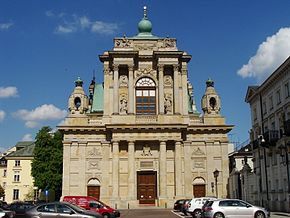Carmelite Church, Warsaw
| Carmelite Church Kościół Wniebowzięcia NMP i Św. Józefa Oblubieńca (in Polish) |
|
|---|---|

Church of the Assumption of the Virgin Mary and of St. Joseph.
|
|
| General information | |
| Architectural style | Baroque (façade Neoclassical, 1761-83) |
| Town or city | Warsaw |
| Country | Poland |
| Construction started | 1661 |
| Completed | 1681 |
| Client | Michał Stefan Radziejowski |
| Design and construction | |
| Architect | Jan Szymon Belotti, Efraim Szreger (façade) |
Church of the Assumption of the Virgin Mary and of St. Joseph (Polish: Kościół Wniebowzięcia NMP i św. Józefa Oblubieńca) commonly known as the Carmelite Church (Polish: Kościół Karmelitów) is a Roman Catholic church at Krakowskie Przedmieście 52/54 in Warsaw, Poland.
The Carmelite Church has Warsaw's most notable neoclassical-style façade, created in 1761-83. The church assumed its present appearance beginning in the 17th century and is best known for its twin belfries shaped like censers.
The present church is the second building to have arisen here, erected over the site of a wooden church originally constructed for the Discalced Carmelite Order in 1643 and burned down by the Swedes and Brandenburg Germans in the 1650s.
The new building was founded in 1661 by Polish Primate Michał Stefan Radziejowski, who also established Warsaw's Holy Cross Church. It was built in 1692-1701 to the plan of Józef Szymon Bellotti.
The church's basic structure had been largely completed by the end of the 17th century, but the present façade was not begun till 1761. It was erected by Prince Karol Stanisław Radziwiłł, who commissioned the German architect Efraim Szreger to draw up a plan for a comprehensive new façade. This impressive façade was built in a style typical for the reign of King Stanisław II Augustus, with dominant columns supporting the cornice.
...
Wikipedia
